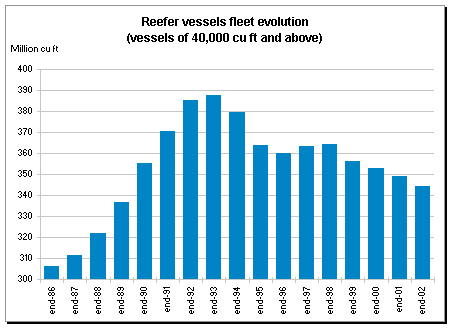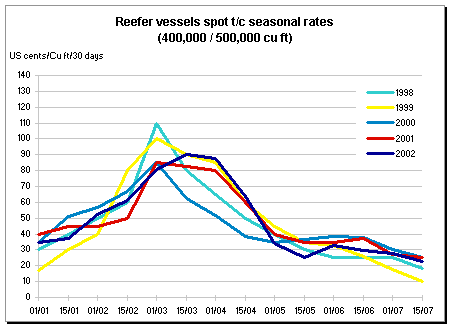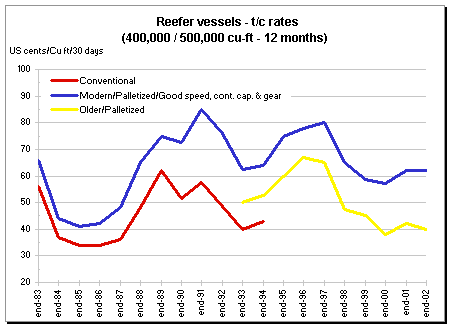
| |
|
The Reefership Market in 2002
Light at the end of the tunnel? |
Competition from containerships
The fleet
Major events in the year 2002
The freight market for conventional ships of 350 to 500,000 cu ft
Conclusion
|
|
At the onset of 2002, an air of optimism swept
through the sector leading many to believe that perhaps the 5 year-long depression was finally
coming to an end. As it turned out, it was only a case of high hopes.
Over the past 5 to 6 years, reeferships have been caught in a difficult context caused by both a
surplus of tonnage and a fierce competition from containerships. Without a substantial reduction in
the transport capacity of conventional reefers, freight rates stand no chance of seeing any real
improvement.
Although in terms of global commercial exchanges the volume of perishable goods continues to grow at
a rate of about 2.5 % per annum, the capacity of transport at regulated temperatures has increased
at a far greater pace with the introduction of modern containerships.
Transport capacity for ships over 1,000 teu rose by 11 % in 2002 (171 ships delivered for 6,190,000
teu), equivalent to 180 million cubic feet of refrigerated space, calculated on the basis of 13 % of
the 40-feet reefer boxes capacity of containerships or the equivalent of about 79,000 reefer plugs.
|
| Competition from containerships |
|
|
Given the ongoing rivalry between pools of reefer
owners and container line operators, the time is righ for a rationalisation of the industry.
After numerous mergers occurring during the previous year, in February 2002 we witnessed the
creation of a new pool, 'Reefer Ship', which combines the ships of Armada Reefer, Eco Ship and
Eastwind. The object of this new pool is to marry a part of the fleet of small ships of Eastwind and
Armada with the larger ones of Lauritzen-Cool, thus achieving better coverage of market
requirements. Together they represent approximately 50 ships and 20 million cubic-feet, including a
considerable share of ships specialised in transporting frozen food.
As with all recently formed pools, Reefer Ship members seek to focus their energies on cost-cutting
measures and boosting the efficiency of their fleets, rather than on competing against one another.
Important structural changes in exporting countries, such as New Zealand and South Africa, have
forced owners to become more flexible in order to face the container-based competition. A
deregulation in apple export procedures in New Zealand, for example, accelerated the switch to
containers. As a result, if up until 1997, nearly all apples were transported in reefers, today, one
third of them is moved via containers.
If previously reefer operators, such as NYK-Star Reefers, Seatrade and Lauritzen-Cool, were used to
dealing only with large organisations, today, in order to meet the needs of a multitude of small
exporters, they have set up 'parcel' services in the main fruit exporting countries of the
Southern Hemisphere.
NYK-Star Reefer launched two new seasonal services. The first kicks off in New Zealand, with port
calls at Nelson and Napier, and serves Antwerp and Sheerness for a transit time of 26 days. The
second trades between South Africa and Russia.
This situation has certainly benefited those exporters fast enough to exploit the container-based
competition to put pressure on reefer owners. The latter have countered by proposing fast ships,
equipped to fit refrigerated containers on deck, and often with atmospheric control systems.
By maintaining the pressure on freight rates and demanding a constant improvement in the quality of
transportation, shippers stand to gain the most from the rivalry between reefer and containership
operators.
In the medium term, unless freight levels are high enough to pay for the renewal of ships, there
will be such an imbalance that owners will be turned away from the conventional reefer market.
Containerships are in the process of increasing their market share at the expense of reefer vessels
on a number of routes. Already, nearly all frozen food exports from South America (with the
exception of fish transhipments) destined to the Far East travel in containers.
Exports in refrigerated containers out of Argentina, Chile, and Brazil heading to the U.S. and
Europe are also on the rise.
Containership owners have been anticipating events:
-
Maersk-Sealand has put into service 6 ships
of 4,500 teu, 800 reefer plugs, 24 knots, to operate from the East Coast of South
America to Europe replacing ships of 2,800 teu.
-
During the autumn of 2002, P&O-Nedlloyd
launched a new generation of containerships of 4,100 teu, 1,200 refrigerated plugs and 25
knots. These 10 ships (7 P&O-Nedlloyd and 3 CP Ships) replace the 2,700 teu ships on
the Australia / New Zealand to Europe / U.S. run.
-
At the start of 2003, MSC is introducing a
new weekly service New Zealand / Europe competing against P&O-Nedlloyd.
If in the past containerships, relative to reefers,
were characterised by slower speeds and inflexible transit times, today, they steam at 25 knots and,
thanks to transhipment systems, are able to better serve shippers'demands, be they small regular
volumes or more important seasonal sizes.
Despite these developments and the fact that the global capacity of containerships fitted with
reefer plugs is more than double that of the specialised fleet measured in cubic-feet, in reality
only half of perishable goods travel in containers. Thus, owners of conventional refrigerated ships
remain highly efficient in their fleet operations and refrigerated containers have yet to adapt to
the most widespread fruit trades, namely bananas and citrus fruit.
However, recent very low levels of freight rates have discouraged owners from renewing their fleet
of conventional reefer ships. Were this situation to persist, one has to question what the future of
this sector will hold. The prospects are all the more dubious if in the meantime liner operators
reduce the transit times for refrigerated containers and improve the efficiency of positioning empty
boxes in production zones in line with seasonal cycles.
|
| The fleet |
|
|
At the end of 2002, the orderbook was virtually empty
with only 3 ships under construction. Rock bottom demolition prices meant that demolition remained
extremely low throughout the year.
Eighteen ships for a total of 6 million cubic feet were sent to the scrapyards.
Paradoxically, activity on the second-hand market for 10 to 15 year old ships was relatively
buoyant. There are two main reasons : first, purchases by existing pool members of ships belonging
to owners who were seeking to exit the sector and secondly, purchases by shippers or importers
seeking a greater degree of independence in their operations. The latter was, for example, the case
for Russian fruit importers as well as for the fishing sector.
As a result, we witnessed a concentration of the fleet in the hands of few owners ' per se, not a
new phenomenon.
In terms of newbuildings, the market is in a state of limbo, as prospects offer little encouragement
to investors for the moment. Activity is likely to return when some 100 to 150 ships of over 250,000
cu ft built before 1978 are scrapped.
|

|
|
It is also worth noting that the latest large
refrigerated ships being delivered have a service speed of 23-24 knots and offer various
innovations: pallet loading by lift, lateral doors independent from container loading on deck, the
absence of hatchcovers, and an impressive refrigerated container capacity reaching up to 70 % of the
hold capacity. These ships of about 600,000 cu ft, 12,000 dwt, have a combined capacity (hold +
deck) of 8,500 to 9,000 pallets.
|
| Major events in the year 2002 |
|
|
Beginning in March 2002, there was a Russian embargo
on American poultry for sanitary reasons (antibiotics, salmonella, etc.), which lasted until mid
May. It is estimated that American exports to Russia dropped by 35 % over the year 2002. The
previous year Russia imported 1,36 million tons of chicken and turkey, of which 1 million came
from the U.S..
Unfavourable weather conditions and the ensuing torrential rains damaged the banana crop in Ecuador,
Costa Rica and Honduras. Australia, on the other hand, suffered from an exceptional drought.
Amer Reefer reached an agreement with the New York bankruptcy court and specifically with creditors
Vroon and Aston Financial Int. Its 7 ships will remain in the Leonina pool of Lauritzen-Cool.
In Argentina, the crisis and the consequent devaluation of the peso spurred exports. Despite the
fact that apple (1 million tons) and pear (500,000 tons) production fell by 20 % compared to 2001,
turnover from fruit exports increased by 20 %,
primarily towards Europe, the Mediterranean area, and Russia.
In Panama, Chiquita plans to sell 3,000 hectares of plantation to a co-operative of agricultural
workers. $90 million losses have accumulated in the last 5 years in this country where irrigation
costs are extremely high.
A dock strike affected 29 ports on the West Coast of the U.S. for 10 days in September, forcing a
re-routing of containerships as well as some banana carriers. Some 260 ships were affected by this
strike.
In Chile, fruit exports increased by approximately 9 %, riding on a strong dollar. 670,000 tons were
exported to the U.S., 437,000 tons towards Europe, and 127,000 tons to Asia. Inversely, a strong
euro could lead to a preference of sales towards Europe in 2003. Consequently, shipowners face the
enticing prospect of seeing tonnage employed on the longer routes between Chile and Europe.
In New Zealand poor weather affected the squash production and exports, mainly to Japan, fell
between 25 to 30 %. The apple crop increased by 4 % compared to 2001 (17,7 million cardboard boxes).
With heavy frosts having affected the apple orchards in the Nelson region, the outlook for 2003
appears to be bleak, the next crop is expected to produce 14,5 million cardboard boxes. On the kiwi
front, bad spring frosts, the worst in 20 years, as well as hailstorms damaged some of the
plantations. The precise result of these climatic conditions remains to be determined, but one can
expect total kiwi production volumes to be lower.
In Brazil, beef exports were strongly up (910,000 tons in 2002, 826,000 in 2001 and 575,000 in 2000)
and the forecast for 2003 is 1,15 million tons, thus becoming the second largest exporter in the
world after Australia.
Banana production in Ecuador declined, because of both climatic reasons (heavy rain and cold
temperatures in March and April) and the mushroom 'black sigatoka'. In addition, threats
concerning a rise of Panama Canal tolls may endanger the bulk of Ecuadorian exports as 60 % of
exports take the Canal route.
In South Africa the deregulation of the old commercial system and the weakness of the rand helped
fruit exports (1,7 million tons of which : 950,000 tons of citrus fruit, 650,000 tons of apples,
pears, and grapes, and 100,000 tons of avocados and other various fruit) resulting in a 6 % increase
in volume over 2001 and 10 % rise in value, with two-thirds going to Europe.
In Costa Rica, between May and June the country was hard hit by torrential rains, the resulting
floods damaging 40 % of its banana plantations. Consequently, banana exports fell by approximately 6
% in the year and the country could find itself being displaced by the Philippines as the second
largest world exporter.
|
| The freight market for conventional
ships of 350,000 to 500,000 cu ft |
|
|
First and foremost, the high season only lasted
several weeks. The market peaked at 90 cents and started to drop off at the end of March. By the end
of April, some 50 ships were already idle in Cristobal.
Relative to 2001, the first quarter performed better, but the second fared worse.
Having plunged in May, the market picked up in June thanks to strong activity in citrus fruit, the
renewed movements of frozen chicken into Russia and a reduction in the spot fleet, as numerous ships
had been laid up after a particularly disappointing high season. It is estimated that during the
summer approximately sixty ships were laid up with about 25 million cubic-feet capacity.
At the end of July 2002, the impact of the drop in volume of banana exports from Ecuador (2 million
cardboard boxes less per week or the equivalent of 10 ships) was heavily felt in the spot market.
The low season has now increasingly shifted to September / October, as during the period from May to
August transport demand for citrus fruit in the Southern Hemisphere remains fairly strong.

There was an excess of optimism in the market during
the summer when freight rates were fixed during the Canary Island export season (from November to
May each year) with an increase of 5 % to 75 cents, but there were only 6 ships fixed of 420,000 to
440,000 cu ft instead of the usual 8.
After that we had to wait until November for the 'Majors' (Chiquita, Dole, DelMonte,
Fyffes-Geest) to renew 12-month time charters at practically the same conditions as last year,
namely 62 cents for the fastest ships with large deck capacity for containers and on average 57
cents for ships of 450,000 to 500,000 cu ft (20 knots, 50'80 reefer plugs for containers on deck).

For standard palletised ships of 400,000 to 500,000
cu ft (18 knots, without container capacity) the market lingered around 40 cents for a 12 month
period, but fixtures for longer periods (over a year) remain a rarity, as operators prefer the
pooling system rather than to take risks on hypothetical time charters.
In the small sizes (about 200,000 to 250,000 cu ft) the market kicked off to a good first quarter
then in April fell back compared to the previous year. The average yearly spot market was around 50
cents.
|
| Conclusion |
|
|
The number of players in the market of conventional
ships has been steadily shrinking. Two developments lie at the heart of this. First, organisations
that have a monopoly on exports in the Southern Hemisphere have broken up and, second, containers
have absorbed a share of the market, either on the deck of conventional reefer vessels, or on pure
container vessels.
The spot market depends in practice on a selected number of goods : fresh fruit such as bananas,
citrus fruit, apples, pears, kiwis, and pineapples ; plus frozen chicken, mainly for bigger vessels
and fish, generally for smaller ones.
Russia continues to play a determinant role as a regular charterer of full ships in terms of bananas
and fruit from the southern hemisphere and Morocco, as well as American poultry. The recent decision
by Russians to acquire second-hand conventional ships will probably lead to a reduction in the
number of fixtures on the spot market.
Competition remains fierce between the two modes of transport (containers versus reefers) and will
become increasingly selective. Whilst the container has taken a preponderant share in the meat, milk
products, and seafood sectors, conventional refrigerated ships should be able to hold their position
in transporting fruit between specialised ports and ports endowed with state-of-the-art fruit
terminals. The latter control loading programmes and focus on the re-distribution of fruit to its
final destination, thus playing a role as a centre of distribution in a sector where the delivery
into the product market is sometimes too complicated for liner owners to operate. To each his own
business'
|
Shipping and Shipbuilding Markets in 2002
I N D E X
|